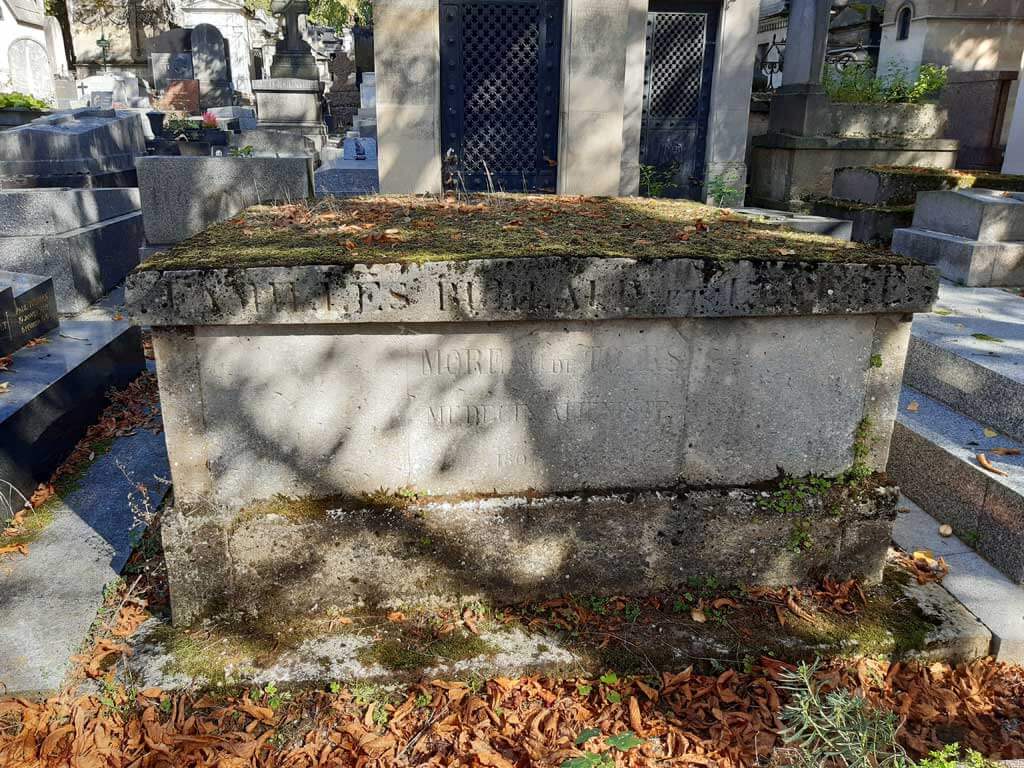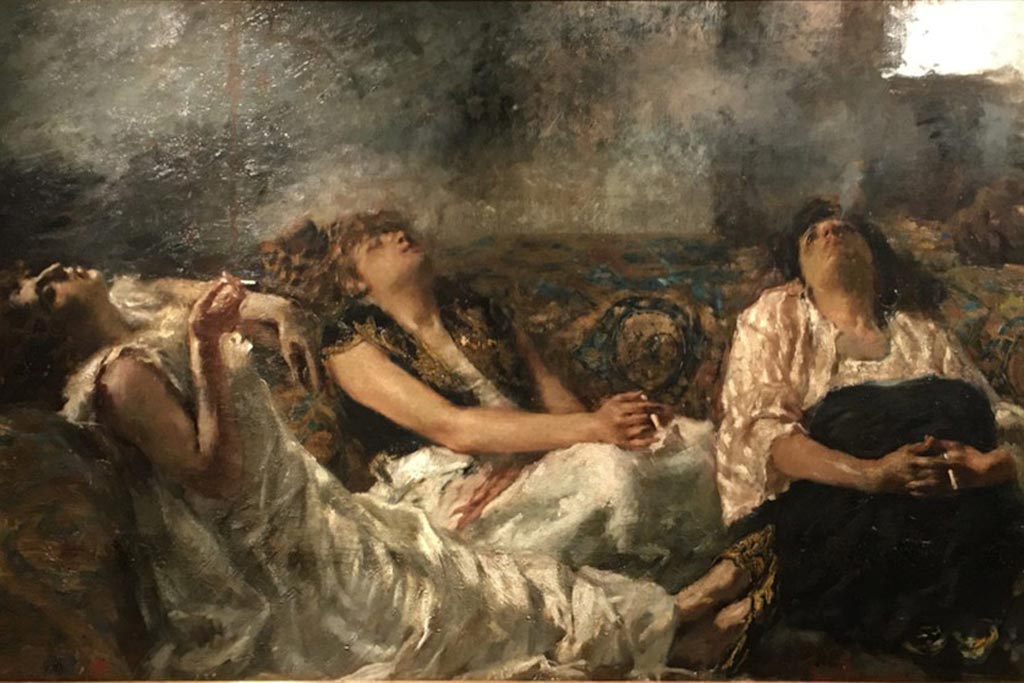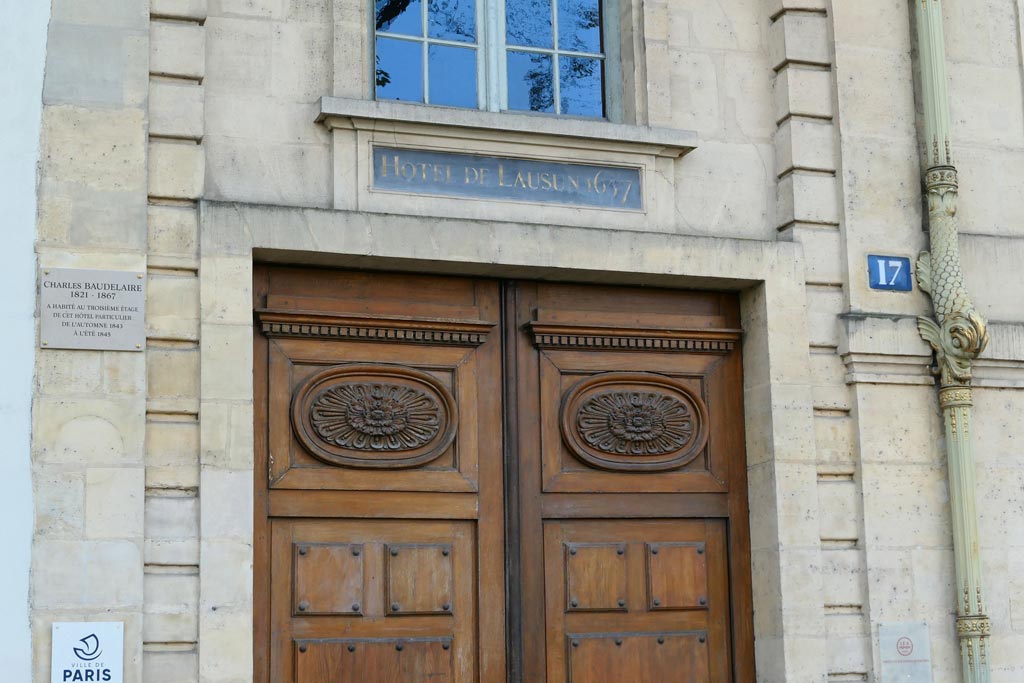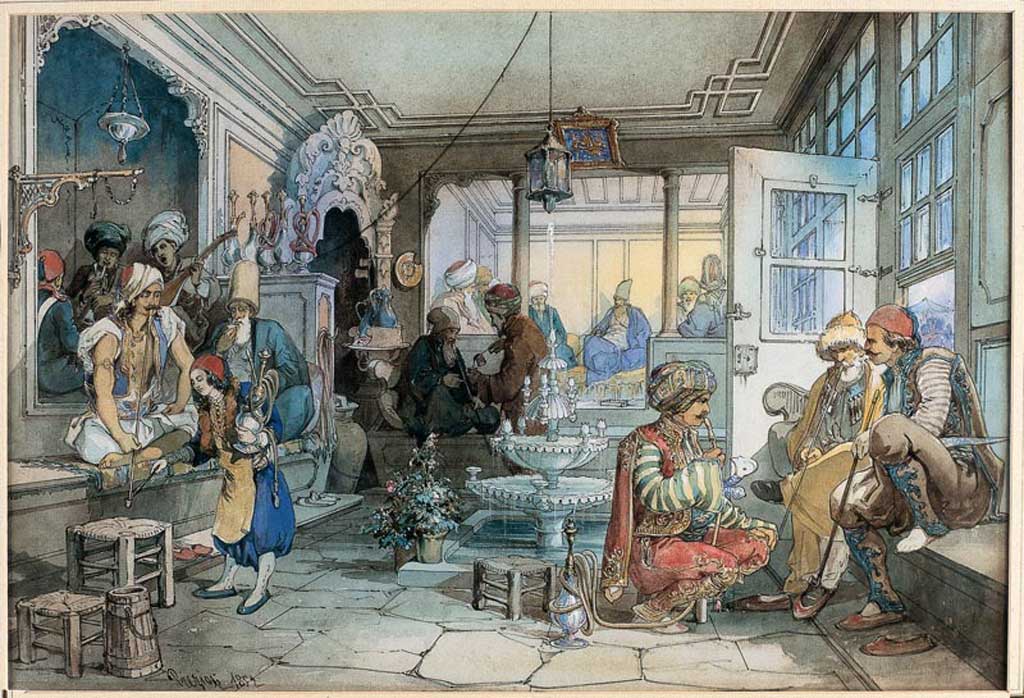In northern Paris, the Père Lachaise Cemetery is a lovely place for a stroll. It is also full of legends and secret stories, jealously guarded by the graves of anonymous and famous people.
In the 3rd Division of the Cemetery, curious wanderers will notice an old tomb which is usually decorated with joints. This tomb belongs to Jacques-Joseph Moreau de Tours (1804-1884), a famous psychiatrist of his time. Here’s the story.

Club des Haschischins History
Paris in the 19th century was a place of enlightenment and exploration, a city alive with intellectual curiosity and cultural revolution. Amidst this backdrop, a unique society emerged – Le Club des Haschischins (the Hashish Eaters Club in English), founded by Dr Jacques-Joseph Moreau de Tours.
Les Club des Haschischins (also known as Club des Hashischins) was an assembly of some of the most influential literary and artistic minds of the era. More than just a social gathering, what made this Club truly unique was its members’ shared fascination with a then-misunderstood substance: hashish.
The Club des Haschischins in Paris was active between 1844 and 1849.
Club des Haschischins’ Fantasies

Driven by a desire to challenge societal taboos and expand their knowledge, the Club’s members indulged in regular hashish sessions, conducting experiments and documenting their findings. These gatherings were also accompanied by lively discussions and debates on various topics, making it not just a scientific inquiry but also a social event for intellectuals.
The Club’s monthly sessions occurred at the Hotel Pimodan on Ile de Saint-Louis in Paris. Nicknamed fantasies, the sessions took place in a dimly lit room decorated with Persian carpets and elaborate oriental furnishing. Here’s a description of this room by one of the Club members:
“The room in which the Club convened had a door hung with a velvet curtain, the walls paneled and covered in discolored gold leaf, the decorated ceilings domed, while the Pyrenean, red-and-white-flecked marble mantelpiece bore a clock in the shape of an elephant with a castellated howdah on its back. The furniture was dated and covered with faded tapestries.”
Dressed up in Arabic clothing, the members started with a cup of strong coffee and dawamesk (a hashish cake made of honey, pistachio, butter, and cannabis resin). A spoonful of this delicious cake was the prelude to a very special feast.
As the effects of the dawamesk set in, members embarked on a journey of exploration and experimentation. At the same time, Dr Jacques-Joseph Moreau de Tours documented their experiences and observations in an effort to better understand the substance.
Moreau de Tours, who didn’t eat the cake, ensured that the sessions and consumption went smoothly. Typically, sessions went through three phases: amplification of sensations, distortion of time, and visual hallucinations. At that point, he usually remained close to the window in case somebody was tempted to take a bad trip through the window!
Who Were Le Club des Haschischins?
The Club des Haschichins boasted an impressive list of guests. Some of these guests produced important artistic works, published hashish-related studies, and inspired the British “Decadents” writers.
Victor Hugo: One of France’s most important writers, he is the author of bestsellers like Les Misérables and The Hunchback of Notre Dame. Victor Hugo often spoke highly of the substance’s ability to enhance creativity and expand one’s perception.
Alexandre Dumas: Another prolific French writer and dramatist, he is the author of classics like The Count of Monte Cristo and The Three Musketeers. In his novels, he often featured themes related to hashish and drug use, proof of his interest in the subject.
Charles Baudelaire: One of the co-founders of the Club des Haschischins (also, he was living in the hotel where the Club met), the writer was a leading figure in the French symbolist movement. His collection of poems, Les Fleurs du Mal, featured a section dedicated to hashish.
Gustave Flaubert: The author of the world-famous novels Madame Bovary and Salammbô, his experiences with hashish were often featured in his novels, which contain themes of escapism and hedonism.
Théophile Gautier: A famous poet, journalist, and literary critic, Gautier was also one of the Club’s co-founders and a close friend of Baudelaire. His novel Hashish, Wine, Opium was one of his most notable works on the subject, documenting his personal experiences with hashish.
The Club des Haschischins’s Impact

The Club des Hashischins broke up in 1849 as Moreau’s scientific goals had been met and his book published. Despite its short existence, the Club is recognized as one of the first formal groups to deliberately investigate and document the impacts of hashish, and their work greatly enhanced the comprehension and broader acceptance of its use.
The Club’s gatherings also popularized drug imagery in arts and literature, transforming its image from a feared or dangerous substance to facilitator for enlightenment and creativity.
The Hotel Pimodan still exists under the name of Hotel de Lausun (17 Quai d’Anjou), which is a few meters away from Notre Dame Cathedral.
Origin of Hashish in France

The first sustained interaction between the French and the hashish eaters of the Arab world occurred during Napoléon’s invasion of Egypt in 1798. Hashish consumption was widely spread in Egypt, and it seems the French soldiers appreciated it, too.
This situation led to a ban on the use of hashish by French troops in October 1800. According to the decree, the substance causes its users to “lose reason and fall into a violent delirium, which often leads them to commit excesses of all kinds.”
However, this prohibition increased the use of hashish among Napoléon’s soldiers! They imported it to France at the end of the campaign.
Dr. Jacques-Joseph Moreau’s interest in the drug was prompted by his travels in Egypt, Turkey, and Syria from 1837 to 1840, where he began extensive studies on hashish. Back in Paris, he co-founded the Club des Haschischins to use the hashish experience as a model of psychosis.

